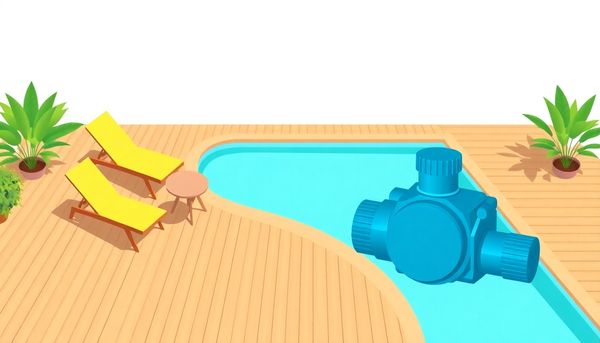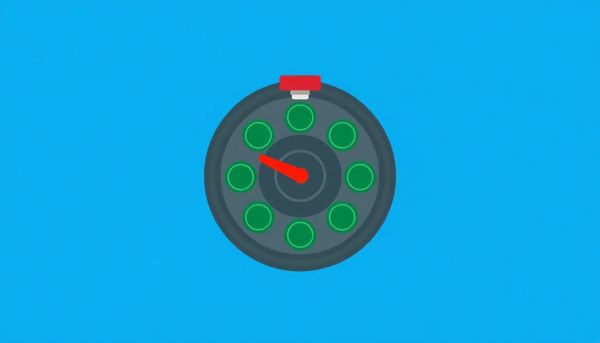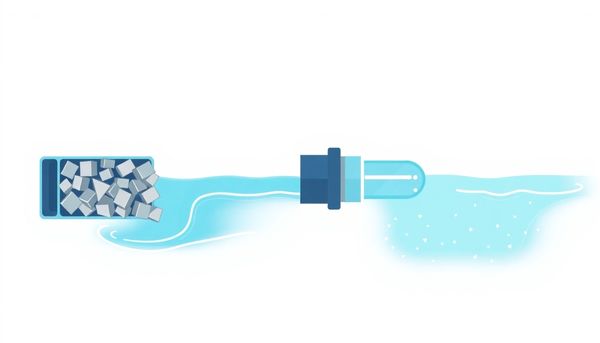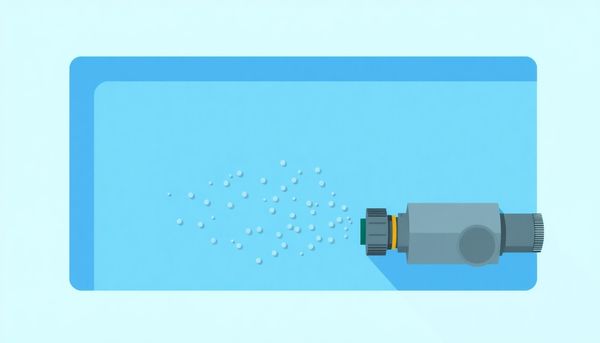Master Pool Maintenance: Unlock the Power of Your Multiport Valve
May 16th, 2024
May 16th, 2024
Handling the multifaceted world of pool maintenance can often feel like mastering an intricate dance. Central to this choreography is the multiport valve on your pool filter—a mechanism with the potential to transform your pool's clarity from murky to sparkling. This vital component, often overlooked, orchestrates several crucial functions to ensure your aquatic oasis remains inviting and pristine.
You might recall that time when you hosted a summer soirée, only to find your pool looking less like a crystal lagoon and more like a murky pond. That’s when understanding the multiport valve becomes a game-changer. With its ability to backwash, rinse, recirculate, and more, this valve is the unsung hero of pool maintenance. Whether you’re preparing for a swim season or winding down for winter, knowing how to manipulate this valve effectively can save both time and frustration.
In this guide, we won't just skim the surface. We’ll journey through the specifics of each valve setting and explore how these functions can optimize your pool’s performance throughout the year. From seasonal shifts to unexpected weather changes, mastering the multiport valve empowers you to tackle any scenario with confidence. By the time you've absorbed these insights, handling your pool will feel less like a chore and more like a well-rehearsed routine.

Encountering the multiport valve for the first time can indeed feel a bit like deciphering a foreign language. Yet, once you get the hang of this versatile tool, you'll soon appreciate its essential role in pool maintenance. This handle, surrounded by a series of settings, empowers you to control the water's path through your pool's filtration system, tailoring its function to your specific needs.
First, always ensure your pool pump is off before touching the valve to prevent potential damage to the internal rubber diverter gasket. This simple precaution can save you from costly repairs down the line. Now, let’s explore the magic of each setting.
When on the "Filter" setting, your system performs its primary task—ensuring your pool is free from unwanted debris and contaminants. However, over time, your filter will need a good clean, which is where the "Backwash" setting comes into play. This allows water to reverse through, expelling trapped debris out through the waste port, effectively cleaning the filter media. Following a backwash, switch to "Rinse" to flush away any remaining particles before returning to "Filter."
If it's pool vacuuming day, consider the "Waste" setting. This setting bypasses the filter media, sending debris directly out of the system. Just keep an eye on the water level, as it will drop during this process. Alternatively, the "Recirculate" setting is perfect when you need to distribute chemicals evenly without filtering them out, such as when using a flocculant to clear cloudy water.
Winterizing your pool? The "Winter" setting allows for safe storage by suspending the diverter to prevent freeze damage. Though rarely used, the "Closed" setting stops water flow, ideal for certain maintenance tasks.
With these settings in your toolkit, navigating pool care becomes straightforward, ensuring your oasis remains inviting and pristine.
When you first encounter a multiport valve on your pool filter, it might seem like a perplexing piece of equipment. Yet, this seemingly intricate device is designed to provide remarkable versatility and ease in pool maintenance. Imagine this: a single handle that guides water through various pathways, achieving different tasks with just a flick of the wrist. This is the power of the multiport valve, a true multi-tasker in the world of pool care.
Each setting on the valve has a distinct role. "Filter" is your everyday hero, capturing debris to ensure water clarity. But when the pressure gauge indicates it's time for maintenance, the "Backwash" setting becomes your ally, flushing out accumulated dirt. Post-backwash, "Rinse" swoops in to prevent residual debris from sneaking back into the pool. During times when you tackle more significant dirt through vacuuming, the "Waste" setting bypasses the filter media altogether, directing water straight out of the system.
Occasionally, you might want water circulation without filtration, perhaps when using pool clarifiers. Here, "Recirculate" comes into play, keeping the chemical in action without interference. While the "Closed" setting is rarely needed, it serves a protective function by preventing water flow during specific maintenance tasks.
By understanding these functions, you transform a daunting mechanism into a user-friendly tool, equipped to handle all your pool's needs with precision and ease.
Every pool owner eventually faces the task of backwashing and rinsing their pool filter. These two steps are essential for maintaining a pristine swimming environment. Let’s take a closer look at how to perform them effectively, ensuring your pool remains a sparkling oasis.
Backwashing is the initial step, and it's like hitting the reset button on your filter. When you notice a 10-pound increase in the pressure gauge from the normal reading, it’s time to act. Begin by turning off the pool pump to avoid any mishaps. Then, position the multiport valve handle to the "Backwash" setting. This reverses the flow of water through the filter, flushing out trapped debris and contaminants to the waste line. Run the pump for about two to three minutes or until the sight glass shows clear water. It’s a simple yet powerful step that ensures your filter media, whether sand or D.E., is refreshed and ready for more action.
Next, don’t forget the rinse. This crucial follow-up step ensures residual dirt doesn’t find its way back into the pool. Turn off the pump again and switch the valve to "Rinse". Let it run briefly, usually around one to two minutes. This process settles the filter media and removes any leftover debris. Once complete, return the valve to "Filter", and your pool is ready to enjoy once more.
Performing these steps regularly will extend the life of your filter and keep your pool invitingly clean. With practice, you'll find these tasks become second nature, adding to the enjoyment of your pool ownership.
Standing before the multiport valve can feel like you're deciphering a secret code, especially when you realize it's not just an on/off switch. This little gadget may seem complex, but mastering its settings can transform pool maintenance from a chore into a streamlined routine. Let's break down how to optimize those settings for maximum efficiency.
First, ensure the filter setting is correctly adjusted. This will be your go-to mode, keeping the pool pristine by capturing debris and contaminants. Remember, the key is to monitor your pressure gauge. When it spikes about 10 psi above normal, it's time to backwash. This setting not only cleans the filter media but prevents any slowdown in filtration performance. Once backwashing is complete, a quick shift to the rinse setting ensures any leftover grime doesn't find its way back into the pool.
Next, consider the vacuuming process. Switching to the waste setting allows you to remove debris without risking a filter clog. While vacuuming, connect a garden hose to maintain the pool's water level, then balance the chemicals afterward. This not only keeps the water clear but also maintains its chemical health.
Finally, when winter approaches, the winterize setting safeguards your equipment against cold damage. This precautionary step secures your investment, ensuring that when spring arrives, your pool is ready for use.
Embrace the multiport valve's capabilities, and pool care becomes not just manageable but remarkably efficient. With practice, you'll maneuver each setting like a seasoned pro, ensuring your pool is always in top condition.

Understanding the intricacies of maintaining your pool filter can seem daunting at first, especially with a multiport valve boasting multiple settings. Yet, mastering these tasks transforms pool maintenance from a chore into a streamlined routine. Start by familiarizing yourself with the backwash setting, a vital step that helps clean out your filter's media. Whether you have sand or diatomaceous earth (D.E.) filters, backwashing prevents clogs and ensures optimal filtration. Remember, it's time to backwash when the pressure gauge reads ten pounds above the normal level.
Once backwashed, don’t overlook the rinse setting. This step is crucial as it flushes out any residual debris, preventing it from reentering your pool. It’s a simple task that saves significant headaches later. Transition your focus to the waste setting, particularly useful when vacuuming. This setting diverts water, along with debris, directly out of the system, ensuring that dirt stays out of the filter media.
Occasionally, you might need to circulate water without filtering, perhaps when using a clarifier like flocculant. In such cases, the recirculate setting is your go-to, allowing chemicals to disperse evenly without straining the filter. Lastly, familiarize yourself with the winterize setting if you live in colder climates. This setting helps safeguard your system from freezing temperatures. Embrace these tasks as part and parcel of pool ownership, and enjoy the clarity and cleanliness that follows.
Ever wondered about that mysterious handle on your pool filter? This, my friend, is the multiport valve—a powerhouse tool for managing your pool's filtration system. Think of it as the traffic director of water flow, skillfully guiding it through various channels to achieve different cleaning tasks.
First, familiarize yourself with its settings. The "Filter" setting is your go-to for regular pool upkeep, ensuring water is cleaned and recirculated efficiently. But when it's time to clean the filter itself, "Backwash" is where you'll want to turn. It reverses the flow, pushing debris out and leaving your filter media refreshed. Follow this with the "Rinse" setting to ensure any residual muck doesn't sneak back into the pool.
Sometimes, you’ll need to vacuum your pool or handle water without filtering. This is where the "Waste" setting comes into play—it directs water out of the system entirely, keeping your filter from getting clogged. On occasions when you need to circulate water without filtering it, perhaps when using a clarifier, the "Recirculate" setting is the hero, allowing water to bypass the filter media.
As you prepare your pool for winter, the "Winterize" setting offers a safeguard against freeze damage by lifting the diverter and allowing water to expand safely. Always remember, never change the valve setting while the pump is running. Doing so protects vital components and keeps your pool's heart—and your peace of mind—intact. With a bit of practice, this multiport valve will become your best ally in pool maintenance.
Every pool owner knows the importance of a pristine swimming environment, yet achieving a sparkling pool often feels like solving a mystery. One of the key steps is backwashing the filter effectively. Imagine it like giving your filter a refreshing shower, washing away the grime that it has diligently collected over time.
Start by switching off the pool pump—this is a crucial step because turning the multiport valve while the pump is running can lead to costly damages. Once it's safely off, move the valve handle to the 'Backwash' position. This setting reverses the flow of water, flushing out debris trapped in the sand or diatomaceous earth (D.E.). You might notice the water running out of the waste line turns cloudy at first, and then gradually clears. Keep an eye on this because clarity is your cue to know the backwashing process is complete.
Next, switch the handle to 'Rinse'. This step is often overlooked, but it's essential. Rinsing ensures that any remaining dirt is expunged from the system and prevents it from sneaking back into your pool. Run the rinse cycle for about a minute or until the water is clear, then return the valve handle to 'Filter'.
In my experience, neglecting these steps can lead to murky waters and frustrated pool days. By backwashing regularly, not only do you extend the life of your filter, but you also guarantee a swim-ready pool that sparkles in the sun, ready for effortless enjoyment.
In the world of pool maintenance, achieving optimal water circulation is akin to orchestrating a symphony. A well-circulated pool not only sparkles with clarity but also keeps harmful bacteria at bay. The multiport valve plays a pivotal role in this symphony, guiding water through its various stages of cleaning and circulation.
Once, I decided to experiment with my pool's circulation by adjusting the multiport valve settings based on a friend's advice. By switching to the "Recirculate" function, water bypasses the filter media, flowing back into the pool without the usual filtration. This was perfect when I needed to distribute a chemical treatment evenly without the risk of clogging the filter or wasting the treatment. My pool's water quality improved noticeably within days.
Moreover, maintaining good water circulation prevents stagnant spots where algae can thrive. Consider the "Filter" setting as your go-to for daily use, ensuring continuous water movement through the filtration media. Conversely, the "Bypass" or "Circulate" option is useful for distributing chemicals like flocculant, which clump debris together, making it easier to vacuum up.
To further enhance circulation, regularly check and maintain your pool's pump and skimmer baskets. These components, alongside the multiport valve, are the unsung heroes of pool maintenance. Just as a well-tuned instrument offers a richer sound, a properly set valve delivers superior water quality. By understanding and utilizing these multiport valve settings, your pool will be a bastion of cleanliness and comfort throughout the swimming season.

Mastering the art of backwashing and rinsing your pool filter is akin to discovering the secret handshake of pool upkeep. This process is essential for maintaining optimal filter performance and ensuring your pool remains invitingly clear. After a period of use, the filtration media—whether sand or diatomaceous earth—can become clogged with debris, reducing efficiency. Backwashing the filter reverses the water flow, flushing out accumulated dirt and grime through the waste port. It’s a bit like giving your filter a spa day.
Timing is everything here. A good rule of thumb is to backwash when the pressure gauge reads about 10 psi higher than its normal operating level. This indicates that the filter has collected enough debris to warrant cleaning. Once backwashed, you must rinse the filter before returning to normal operation. This step is crucial; it prevents dirty water from sneaking back into your pool.
The Rinse setting is your filter’s reset button, allowing water to flow through the filter, settling the media into place and expelling any residual dirt. It's a quick step but essential—think of it as the final rinse after shampooing, ensuring no suds remain. Remember, every time you backwash, follow up with a rinse to keep the pool water sparkling and the filter functioning at its best. Each backwash and rinse cycle not only prolongs filter life but also offers you more time to enjoy your pool, worry-free.
Standing before your new multiport valve can indeed feel like deciphering a secret code. But once you understand the settings, it's like having a toolkit for every pool scenario. Each position on the valve serves a specific purpose, transforming your pool maintenance from a daunting task into a breeze.
Imagine you've just returned from a vacation, and your pool looks more like a pond. Switching the valve to "Filter" will revive your oasis. This setting is your default, channeling water through the filtration media to remove debris and particles effectively.
Now, if your filter starts to complain with increased pressure, it's time for a "Backwash." This setting cleans out your filter media by reversing water flow, expelling captured dirt and grime. Follow this with a "Rinse" to ensure no leftover debris makes its way back into the pool.
When the pool bottom needs vacuuming but you don’t want the debris re-entering the water, "Waste" becomes your ally. It directs dirty water out of the system entirely, bypassing the filter.
For circulating chemicals or flocculants without filtering, "Recirculate" keeps the water moving without passing through the media. On the other hand, when blowing out lines at season's end, "Closed" seals the system, although use it sparingly to avoid damaging your equipment.
Finally, prepping your pool for winter involves the "Winter" setting, delicately suspending the valve's internal mechanisms to prevent freezing damage.
Each setting of the multiport valve offers a specific solution, making pool upkeep straightforward and efficient. With practice, you'll navigate these options with ease, ensuring a sparkling, inviting pool all season long.
When it comes to maximizing your pool filter’s performance, backwashing is an indispensable task. Think of it as a spa day for your filter. Over time, debris and impurities accumulate within the filter media, reducing its efficiency. Backwashing reverses the flow of water through the filter, flushing out these unwanted particles and rejuvenating the filter's effectiveness.
The process begins by turning off the pool pump—an essential first step to avoid damage. Next, position the multiport valve to the ‘Backwash’ setting. Once the pump is restarted, watch as a steady stream of cloudy water exits through the waste line, a visual testament to the dirt being expelled. Typically, this stage takes a few minutes; however, keep an eye on the sight glass or waste line for clear water as a sign to stop.
After backwashing, transitioning to the ‘Rinse’ setting is crucial. This step settles the filter media and ensures that residual debris doesn't sneak back into your sparkling pool. A minute or so on rinse should suffice. Once complete, switch back to the ‘Filter’ setting, and your pool filtration system is ready to return to its primary duty: keeping your pool pristine.
Regular backwashing maintains optimal pressure levels and extends the life of your filter. Remember, a well-cared-for filter not only ensures clarity but also reduces wear on your pool’s pump, promising many years of carefree swimming under the sun.
Imagine you’ve just backwashed your pool filter, feeling accomplished as dirt and debris wash away. But hold on—before you let the water flow back into the pool, there's an essential step to tackle: rinsing. This crucial action prevents any leftover grime from sneaking back into your pristine pool, ensuring that your effort wasn’t in vain.
After backwashing, the filter media is loosened, and traces of dirt might still cling to it. If not rinsed, these remnants could re-enter the pool and undo all your hard work. Switching your multiport valve to the "Rinse" setting runs clean water through the filter, catching any leftover particles and flushing them safely out of the system.
Think of this step as a final polish. It’s akin to rinsing shampoo out of your hair—necessary to ensure nothing unwanted lingers. The rinsing process typically lasts for about 30 seconds to a minute, but it’s worth every moment. Trust me, I've learned this step the hard way after a few murky mishaps.
Incorporating the rinse into your routine transforms your pool maintenance from a simple chore into an efficient practice. It’s a small investment of time that rewards you with sparkling, uncontaminated waters, ready for your next swim. So next time you handle that multiport valve, remember: rinse to keep your pool a haven of clarity.

Keeping your pool pristine often feels like a battle against clogging, especially when vacuuming. A multiport valve can be your best ally in this endeavor. When vacuuming your pool, you'll want to avoid any blockages that could disrupt the process. The "Waste" setting on your valve is the secret weapon here. It allows pool water—and all the debris you’re vacuuming up—to bypass the filter media entirely, redirecting it straight out of the system. This prevents the accumulation of leaves, dirt, and other debris in your filter, which could lead to clogs and a drop in filtration efficiency.
I remember the first time I vacuumed my pool without this knowledge, only to find the filter almost bursting at the seams with gunk. Lesson learned. Now, before starting, I make sure to connect a hose to replenish the pool's water level as it drops during the process. This simple prep step ensures that while the debris is being efficiently removed, the pool remains full and ready for a swim afterward.
Remember to manage the disposal of the expelled water responsibly. It’s an opportunity to think about how our actions impact the environment. This attention to detail not only keeps your pool in top condition but also contributes to a more sustainable pool maintenance routine. So go ahead—embrace the power of the multiport valve and say goodbye to those pesky clogs.
Not all adventures involve epic quests or grand voyages. Sometimes, the thrill lies in mastering a piece of equipment, like your pool's multiport valve. The myriad settings, each with a unique function, transform your pool maintenance routine from a mundane task into an experience of skilled precision. This valve is your tool for directing the flow of water, adapting your approach to various needs, whether it's for cleaning, closing, or maintaining.
Let's start with backwashing. When your filter pressure rises, signaling it's time for a thorough clean, the backwash setting becomes your ally. It reverses water flow through the filter, expelling trapped dirt and debris through a waste port. This is a powerful step to ensure the longevity and efficiency of your filtration system. Following backwashing, don't skip the rinse setting. This crucial step settles the filter media back in place and prevents any unwelcome debris from sneaking into the pool.
What about vacuuming your pool? The waste setting is your go-to option. It allows you to bypass the filter, ensuring that larger debris doesn't clog the filtration system while removing it directly from the pool. Just remember to monitor your water level and adjust as needed, avoiding any unintentional drainage issues.
Each setting on the multiport valve serves a deliberate purpose, designed to enhance your pool care routine. With practice, you’ll find yourself leveraging these settings with ease, keeping your pool pristine and inviting. Enjoy the process, and remember, mastery is just a few turns away.
When dealing with pool maintenance, preventing filter clogs becomes an art of anticipation and regular care. In the heart of summer, the pool becomes a magnet for leaves, pollen, and the occasional unexpected debris. Each of these elements holds the potential to obstruct your filter, compromising not just the clarity of the water, but the overall health of your pool. An unclogged filter not only ensures cleaner water but also lessens the burden on your pool’s pump, extending its lifespan.
Begin with a routine inspection. Every week, make a habit of checking the skimmer and pump baskets. These act as the first line of defense before water reaches the filter. Removing obvious debris helps maintain a freer flow, reducing the strain on your filter. Once, I found a small twig lodged in my skimmer that had been causing a gradual slowdown—something easily fixed with a quick check.
Then, consider the importance of backwashing. It's the go-to solution when your filter system involves sand or diatomaceous earth. Regular backwashing cleans out the accumulated debris, pushing it out through the waste port. Keep an eye on your filter's pressure gauge; when it reads 10 psi over the normal range, it’s time for a backwash. Don't forget to follow up with a rinse cycle to ensure no residual dirt re-enters your pool.
Lastly, embrace preventive measures like using filter aids. These products enhance filtration by creating a finer mesh for capturing smaller particles. A good friend once swore by adding a bit of D.E. powder to his sand filter; it made a noticeable difference in clarity and maintenance ease. With these steps, your filter remains a staunch ally in the quest for crystal-clear waters.
Backwashing might sound like a complicated process, but it's quite straightforward and essential for maintaining your pool filter's efficiency. My first attempt was a bit nerve-wracking, but I quickly got the hang of it, and now it’s second nature. To start, make sure your pool pump is turned off. This is crucial, as fiddling with the multiport valve while the pump is running can damage the internal components.
Next, rotate the multiport valve to the 'Backwash' setting. It's always a good idea to follow the manufacturer's instructions for your specific filter model, as the duration of backwashing can vary. Typically, it takes about two to three minutes. You’ll know it’s working when you see clear water flowing from the waste line.
Once the backwashing process is complete, switch the valve to the 'Rinse' setting. This step is often overlooked but is vital to ensure that any remaining debris is flushed out, preventing it from returning to your pool. Allow the rinse to run for about a minute, then set the valve back to 'Filter'. This completes the cycle and ensures your filter media is clean and ready to keep your pool sparkling.
By incorporating these proper backwashing techniques into your routine, you safeguard your filter's longevity and efficiency, making pool maintenance less daunting and more enjoyable.

Flocculant use might sound like sorcery, but it’s actually a straightforward process that can transform your pool from murky to magnificent. When your pool water resembles a foggy morning, flocculant steps in to help. This magical substance gathers those pesky particles that cloud your water, bundling them into larger clumps that can be easily vacuumed away.
To orchestrate this clear-water miracle, your multiport valve becomes your best ally, specifically the “Recirculate” setting. By selecting this option, the pool water flows through the system without passing through the filtering media. This ensures the flocculant stays in the water long enough to perform its task effectively, rather than being prematurely whisked away by the filter. It’s like giving your pool a chance to marinate in clarity.
For those who prefer to sidestep the slow process of allowing the flocculant to settle, the “Waste” setting provides an alternative. This setting allows you to bypass the filter entirely, flushing the clumps out of the system. While this method might lower your pool’s water level, it’s a small price to pay for crystal-clear water.
Remember, once the flocculant has worked its magic, it’s time to vacuum the pool thoroughly. This final step ensures that all those gathered particles are promptly shown the exit, leaving behind nothing but pristine, inviting water.
Understanding multiport valve settings is like unlocking a treasure chest of pool maintenance possibilities. This versatile tool transforms your pool filter from a simple cleaner to a multifunctional device, ready to tackle a range of pool-related tasks. Your first step to optimization is recognizing when each setting shines.
For instance, keeping your pool’s water pristine is a breeze with the Filter setting, perfect for everyday use. But when the pressure gauge climbs ten pounds above normal, it’s backwash time. This setting sends water through the system in reverse, cleaning out debris from the filter media. Ever been caught off guard by murky water after backwashing? Utilize the Rinse setting to prevent leftover dirt from re-entering your pool.
Every pool owner dreads the sight of debris floating around, but the Waste setting comes to the rescue. When vacuuming, this setting allows water to bypass the filter media, expelling debris directly out of the system, and ensuring your filter stays unclogged.
Sometimes, you need water circulation without filtration—enter the Recirculate setting. Ideal when using flocculants, it keeps particles suspended without filtering them out prematurely.
Lastly, the Closed and Winterize settings are crucial for seasonal transitions, safeguarding your equipment during downtime. Keep the pool pump off when these settings are engaged to prevent unintentional damage.
Mastering these settings not only simplifies pool upkeep but also extends the life of your equipment, making pool maintenance less of a chore and more of an art.

This article provided insights into maintaining your pool. Start your pool care journey today!
Want to become a pool maintenance expert? Our free Pool School course covers everything you need to know about pool care. From basic maintenance to advanced troubleshooting, you'll learn how to:
Join over 10,000 pool owners who have already transformed their pool care routine. Get started with our free Pool School course today!